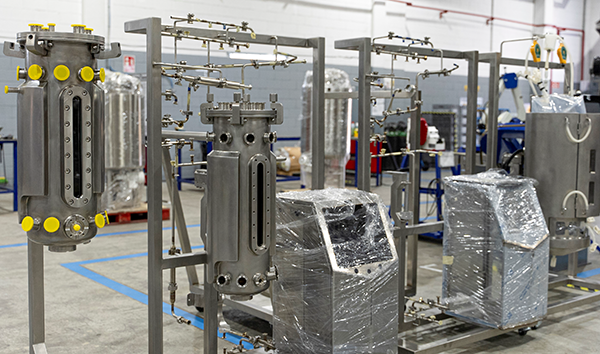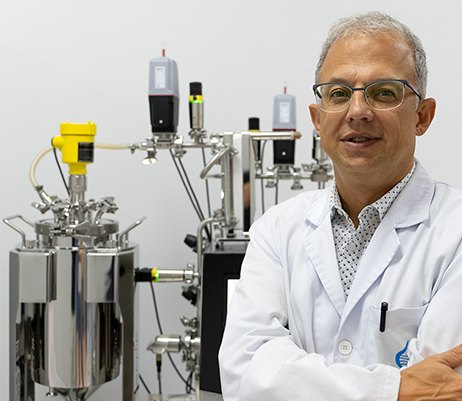Biotechnology is in an interesting phase right now. The conversion of several chemical and pharmaceutical processes into biotechnology is now taking place. The Spanish company TECNIC Bioprocess Equipment Manufacturing, which assists its clients during all stages of the implementation of a bioprocess, is in the middle of this. The company uses measurement equipment from VEGA for level and pressure instrumentation.
The company, which was established ten years ago, is developing at a fast pace. TECNIC is a leading manufacturer of equipment for biotechnological and pharmaceutical applications for labs, pilot plants, and large-scale production facilities, with a manufacturing area of 5,000 m2.
TECNIC employs BSL2 facilities for cell and microbial cultures to serve its customers.
We support our customers in the planning of equipment used for upstream or downstream processes as well as the scale-up phase. We act as a link between the R&D and production departments, offering scalable solutions to speed up the industrialization process.
Manel Estany, Operations Manager, TECNIC
In 2018, a new department for biotechnology was added, but in the first several years, the emphasis was solely on pharmaceutical applications. Since then, the company has been involved in all significant biotechnology procedures. It manufactures equipment for upstream (bioreactors and reactors) and downstream operations (tangential flow filtration).
Equipment for lab (eLAB), pilot (ePILOT), and production (ePROD) applications are available from TECNIC in a variety of configurations.
The temperature, pH level, partial pressure of oxygen (pO2), concentration of dissolved gases, optical density (TCD), cell density (VCD), and dissolved CO2 can all be controlled in bioreactors to replicate the ideal conditions for the growth of the cell or microbial cultures.
For instance, a “cascade control” system, which includes aspects, such as stirring, ventilation, or oxygen-enriched aeration, regulates the amount of dissolved oxygen in the culture medium.
Sterile influx valves and a completely aseptic sampling system were created and intended to be coupled to the Sterilization in Place (SIP) system to guarantee the sterility of the biological reactor.
A Wide Range of Sensors

Image Credit: VEGA Grieshaber KG
The processing systems are equipped with a range of VEGA sensors. These transmit their 4-20 mA analog and digital signals to TECNIC’s eSCADA software. The software, which is built on the AVEVA platform, maintains the control parameters and makes sure that the recipes are followed in accordance with GAMP5 and CFR21.
The VEGABAR 28 sensor is essentially the industry standard for measuring pressure. It controls how sterilizing procedures in bioreactors are carried out. To maintain 1.3 bar pressure, the sensor is essential. The globally used VEGABAR 28 pressure sensor has a ceramic measuring cell and can measure gases, vapors, and liquids up to 130 °C.
The dependable ceramic CERTEC® measuring cell, which has a high overload resistance in addition to good long-term stability, serves as the sensor element. Additionally, the CERTEC® measuring cell is a dry cell without any oil filling, reducing any danger of contamination.
The VEGABAR 29 is the standard pressure sensor used in tangential flow filtration systems (TFF), or the downstream applications of biotechnological processes.
The Trans Membrane Pressure (TMP), a crucial process variable for effective filtration, is monitored by the sensor. This process parameter is the average pressure of the inflowing material on the permeate side of the diaphragm.
The tangential filtration system (TFF) from TECNIC is entirely automated, allowing the TMP to be pre-defined and the process to be managed via a retentate valve.
Although the company seldom uses the capacitive rod probe VEGACAL 62, it is highly valued in the Cleaning in Place (CIP) components due to its exceptional chemical resistance.
There, the level is continually measured. In contrast, VEGAFLEX 81 is more commonly utilized at various process stages, such as when checking the tank level for tangential flow filtering. It provides reliable measured values, which are essential for tank regulation.
Wherever ASME-BPE, EHEDG, or GMP requirements have to be followed, such as during pump operation, the level is monitored using the level switches VEGAPOINT 11 and VEGAPOINT 23.
Sterilization procedures can be handled by these sensors as well. They install quickly and easily since they include universal connections for hygienic adapters. The sensors can be used without being calibrated or adjusted.
For non-critical volume monitoring that does not require direct contact with the medium, the compact radar sensor VEGAPULS 21, which can also tolerate CIP procedures up to 80 °C, is employed.
The VEGAPULS 64 radar level sensor, which is perfect for measuring various significant volumes in the processes, should be used if non-contact level sensing with improved accuracy and hygiene compliance is required. This 80-GHz radar sensor is ideal for applications involving SIP procedures since it was created for continuous level measurement of liquids.
Particularly in locations where the ASME-BPE, EHEDG, or GMP regulations do not apply, the vibrating level switches VEGASWING 51 and VEGASWING 61 are installed in the bioprocessing systems.
Viscous and Turbulent Media Conditions
For these complex, high-tech operations, reliable measured results are essential. The company has used sensors from VEGA for pressure and level monitoring nearly entirely since it began producing bioprocessing equipment five years ago.

Image Credit: VEGA Grieshaber KG
Estany added, “Due to the sterilization processes, the temperatures range from –10 °C to +140 °C in most applications. We often have to deal with viscous and turbulent media, but also the steam and CIP spray heads put a strain on the sensors.”
Service and Support Very Much Appreciated
“We especially appreciate the reliability of VEGA sensors. But the service and above all the worldwide technical support VEGA provides are also very important to us, because we sell our bioprocessing systems on the international market,” Estany further stated.
He and his colleagues believe that one of the most remarkable qualities of the sensors is their Bluetooth connectivity.

Image Credit: VEGA Grieshaber KG
While citing his personal experience in conclusion, Estany noted, “The wireless connection for the adjustment and monitoring of devices is extraordinarily useful for commissioning and verification. It also allows us to identify errors and discrepancies much more quickly in our day-to-day work.”

This information has been sourced, reviewed and adapted from materials provided by VEGA Grieshaber KG.
For more information on this source, please visit VEGA Grieshaber KG.